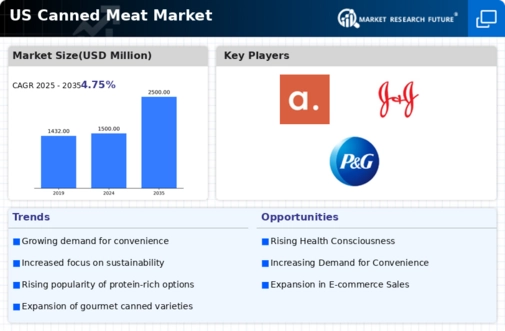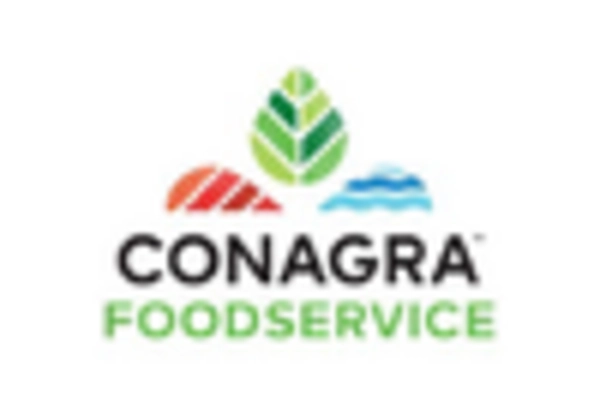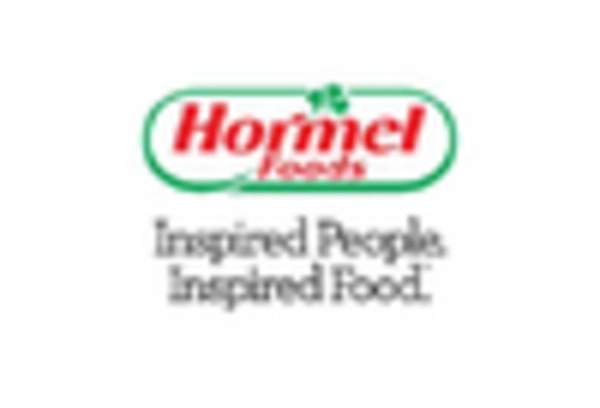Expansion of Distribution Channels
The expansion of distribution channels is a key driver for the canned meat market. Retailers are increasingly recognizing the value of offering a diverse range of canned meat products to meet consumer demand. This trend is evident in the growth of online grocery shopping, which has become a significant channel for food sales. The canned meat market is likely to see enhanced accessibility as more retailers, including e-commerce platforms, stock a variety of canned meat options. This shift not only caters to changing consumer shopping habits but also allows manufacturers to reach a broader audience. As distribution networks continue to evolve, the potential for increased sales and market penetration in the canned meat sector appears promising.
Innovations in Packaging Technology
Advancements in packaging technology are significantly impacting the canned meat market. Innovative packaging solutions not only enhance product shelf life but also improve convenience for consumers. For instance, vacuum-sealed cans and easy-open lids are becoming increasingly popular, catering to the needs of modern consumers who value efficiency. The canned meat market is likely to see a rise in sales as these innovations attract a broader audience. Additionally, sustainable packaging options are gaining traction, aligning with consumer preferences for environmentally friendly products. As a result, companies that invest in cutting-edge packaging technologies may experience a competitive advantage, potentially leading to increased market share and profitability in the coming years.
Rising Demand for Protein-Rich Foods
The increasing consumer focus on protein intake is driving growth in the canned meat market. As health trends evolve, many individuals are seeking convenient sources of protein, which canned meat products provide. According to recent data, protein-rich foods have seen a surge in popularity, with the market for canned meat projected to grow at a CAGR of approximately 4.5% over the next five years. This trend is particularly evident among busy professionals and families looking for quick meal solutions. The canned meat market is thus positioned to benefit from this shift, as consumers prioritize nutritional value alongside convenience. Furthermore, the rise of fitness culture and dietary preferences that emphasize high-protein diets further supports this demand, indicating a robust future for canned meat products in the American food landscape.
Growing Popularity of Outdoor Activities
The resurgence of outdoor activities, such as camping and hiking, is contributing to the growth of the canned meat market. As more individuals engage in these activities, the demand for portable, non-perishable food options rises. Canned meat products are particularly appealing due to their long shelf life and ease of preparation, making them ideal for outdoor enthusiasts. The canned meat market is likely to benefit from this trend, as consumers seek convenient meal solutions that can be easily transported. Market data suggests that sales of canned meat products have increased by approximately 15% in regions with high outdoor activity participation. This trend indicates a promising opportunity for manufacturers to target this demographic with tailored marketing strategies.
Economic Factors Influencing Consumer Choices
Economic conditions play a crucial role in shaping consumer behavior within the canned meat market. During periods of economic uncertainty, consumers often gravitate towards affordable food options, leading to increased sales of canned meat products. The canned meat market appears to be resilient in the face of economic fluctuations, as these products typically offer a cost-effective alternative to fresh meats. Recent data indicates that the average price of canned meat has remained stable, making it an attractive option for budget-conscious consumers. Furthermore, as inflationary pressures continue to affect food prices, the demand for economical meal solutions is likely to persist, positioning the canned meat market favorably in the current economic landscape.

















Leave a Comment